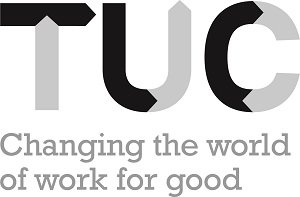TUC's ethnicity and gender pay gap 2023
The TUC advocates that:
- all employers should publish information about their gender pay gap, to support the fair treatment and reward of all workers irrespective of gender
- all employers should publish information about their ethnicity pay gap, as an important first step towards tackling the pay penalty experienced by Black and minority ethnic (BME) workers
- all employers should put in place action plans to address pay gaps identified by their analysis.
The TUC is not required to publish our gender pay gap, as we have fewer than 250 employees. However we choose to publish both our gender and our ethnicity pay gaps.
Pay at the TUC
The TUC’s pay system covers grades ranging from manual to managerial levels. Grades have been fully job evaluated in accordance with equal pay principles. All jobs are allocated to the relevant grade according to the level of responsibility and skills required in the role. Most grades have three pay points and staff are expected to move through these with length of service. The TUC does not pay bonus pay.
TUC’s gender pay gap
Comparison of mean pay at the TUC shows that there is a gap of 4.7 per cent between men and women’s pay at April 2023. Comparison of median pay shows that there is a gap of 10.2 per cent in favour of men.
The gap has increased over the year. This relates in part to turnover of female staff in the highest grades and recruitment of women at the lowest grades, depressing women’s pay. We think this will have a temporary effect.
In a small organisation, relatively small changes, can have an impact on our overall pay gap figures. We continue to keep a watchful eye on this data to make sure it does not reflect more significant underlying issues which require action.
At the TUC, 61 per cent of people in the lower pay quartile are women, as are 62 per cent in our lower middle quartile. Women make up 56 per cent of our upper middle quartile, and 51 per cent of our upper quartile.
TUC’s ethnicity pay gap
Comparison of median pay at the TUC shows that there is a gap of 12.1 per cent between white and BME staff pay at April 2023, similar to last year. Comparison of mean pay shows a gap of 7.5 per cent in favour of white staff, a welcome reduction from last year. At the TUC, 41 per cent of people in the lower pay quartile are BME, as are 25 per cent in our lower middle quartile. BME staff make up 32 per cent of our upper middle quartile of pay, and 23 per cent of our upper quartile.A relatively high proportion of the lowest paid quartile of our staff are BME. We directly employ staff in our cleaning, catering and support roles, rather than outsourcing them as in many organisations. These jobs are in the lowest quartile of our pay bands. Reflecting the occupational segregation experienced by BME workers across the labour market, these roles are more likely to be filled by BME staff. We are a Living Wage employer. Predominantly, more of our BME staff work in roles which attract London weighting.
We have acted to increase the number of BME staff in middle and senior roles and will continue to take action to increase the diversity of our staff in higher pay quartiles, and improve our ethnicity pay gap.
What we are doing to eradicate our pay gaps and ensure fairness for all our staff
TUC is committed to fair pay regardless of gender and race. We have taken action towards eliminating pay gaps:
- We have simple pay structures to help us avoid bias. For example, our pay scales have only three pay points, and we don’t pay bonuses or performance-related pay. All new appointees will start on the first pay point to avoid any indirect pay disparity.
- We have chosen to have a narrower gap between our top and bottom earners than many employers.
- We recognise staff trade unions and negotiate our pay and conditions with them.
- Women and men work at all levels of the organisation. Five of our seven-strong senior leadership team are women, including Kate Bell, our Assistant General Secretary. . Posts on lower grades are fairly evenly divided between women and men.
- We support women who have children with fair maternity leave and flexible working policies. We also provide financial support for childcare, adoption leave and paid parental leave. We encourage men to play a full part in parenting by offering fully paid paternity leave, shared parental leave and time off to attend antenatal appointments.
- We support BME and female employees’ career progression through training and development opportunities We have taken steps to prevent bias in recruitment wherever we can – for example, by anonymising applicants’ personal details during shortlisting, removing educational institutions from applications and aiming to ensure every recruitment panel includes at least one woman and one BME panel member or someone reflecting both protected characteristics.
In 2018, we recognised we needed to do more to make our staff profile reflect the predominantly London base of the TUC, particularly at senior grades. We set an aspiration to fill 50 per cent of recruited posts at more senior and regional levels with BME staff. As part of this work, we revised and improved our recruitment processes to support, encourage and inform BME applicants. In the year to end of June 2023, 37 per cent of our more senior and regional recruited posts were filled by BME staff. As part of our commitment to build a more inclusive TUC, we have listened to our exiting staff and continue to build a programme of activities based on these conversations and findings. In 2023 the first cohort of BME staff completed a talent development programme and we will be continuing this programme in 2024.
The TUC will continue to monitor our pay gaps and take action to ensure we are treating all our staff fairly and reflecting the diversity of trade union members.
I, Paul Nowak, General Secretary, confirm that our calculations are accurate and that our gender pay gap has been calculated in accordance with ACAS guidance.
Paul Nowak, General Secretary



